As an Amazon Associate I earn from qualifying purchases.
The piano is one of the more interesting instruments out there. Learning how to play it is certainly a fun task and knowing how it works can actually be really beneficial. The way the piano works has always been a fascinating thing to me, so I decided to research it and share some of my findings here.
So, how does the piano work? When a key is pressed a small padded hammer inside strikes the metal strings. The damper lifts above the strings which allow them to vibrate above the spruce soundboard. The sound is projected into the room and stops when the key is released and the damper falls back into it’s resting position.
That’s just the basics of what the piano does whenever you strike a key. There are a lot more details that actually go into the overall function of the instrument and I’ll share some of those details next.
Want to Learn Piano?Click Here
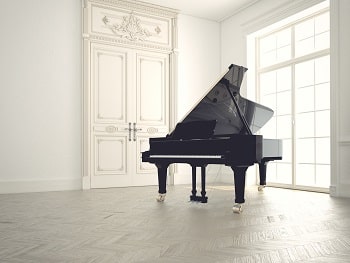
How The Piano Action Works
The most important mechanism in any piano is the action. Without it, there is no way to produce sound. Not only is it the most important part, but it’s also the most complex part of the entire instrument. It features around 9000 different parts all moving in concert with one another.
Understanding how the entire action works can give you a better understanding of what exactly happens when a key is pressed. Most pianos use hammer action to produce sound. When the key is pressed, the hammer lifts up; transferring whatever force you played to the strings.
Below is a diagram of how the mechanism is built.
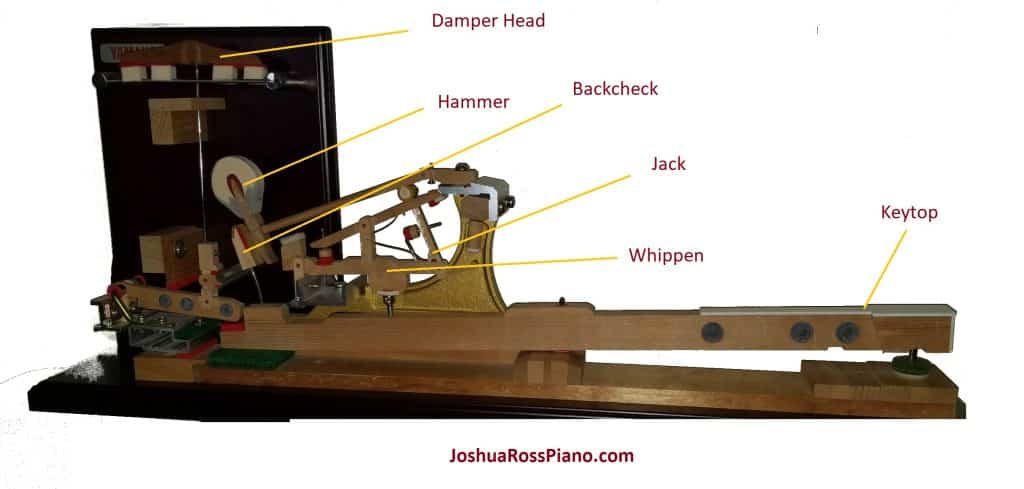
In that diagram, you can see every part that makes up the action from the front to the back in a grand piano. While all parts of the action are important, these are a few parts we’ll focus on for this example. Let’s start off with the key itself.
Key – Often referred to as the keytop, this is the visible part of the action that pianists and audiences see. It’s typically made with an ivory substitute or a plastic combination. This part is also made completely of wood and has small weights placed inside that measure in grams.
These weights can be added or taken out by a piano technician as they control the touchweight needed to depress and lift the key.
Hammer – The hammer is what physically comes into contact with the metal strings. Most piano hammers are made of wool that’s been tightly compressed. Some pianos also use hammers made of wood that is covered in a soft felt material. The material is gentle on the strings but will wear down after years of repeated use.
All of the hammers are not the same size; with a gradual decrease from the bass to the treble region of the piano. For the bass strings, the hammers are larger. For the treble strings, the hammers are smaller. The tenor region located around middle C also uses a medium size hammer.
When it comes to tone, the hammers have a huge impact. When using the una corda pedal, for example, only a portion of the hammer is used to strike fewer strings to produce a quieter sound. The felt material can also be softened, reshaped, poked, and even completely replaced to produce a different tone.
Damper – The damping does exactly what its name suggests; dampens and stops any sound that is produced. When used in playing the pianist has a lot of control with this. They can use the pedals to manipulate the damper, and also control it with their hands.
The piano damper head sits directly on the strings and is made with a combination of a wood body and felt on the bottom. When a key is pressed, the lever is raised, the flange located behind the key rotates, and the wire connecting the damper head to the guide rail rises.
This process lifts up the damper head so that the strings are free to vibrate. Another way this is accomplished without pressed the key is by use of the sustain and sostenuto pedal (more on this later).
When looking at the grand piano you’ll notice that not all of the strings have dampers over them; particularly in the higher register. This is because treble strings don’t produce the same length or level of sound and naturally dampen themselves.
Repetition Lever – The repetition lever is attached to the whippen. Its essential function is to allow pianists to play a note repeatedly. This is also achieved while also negating the need for the key to rising back to it’s resting position.
The mechanism allows the jack to reset itself under the knuckle. This is often referred to as double escapement and helps pianists perform all types of technically difficult passages with accuracy and ease.
Some examples of this are repeated notes, finger substitution, trills, glissandos, and more. The repetition lever has only been around in grand pianos since it’s creation in 1823 by Sebastien Erard. Since then it’s gone through many iterations into what it is now today.
Backcheck – This is the felt material that’s attached to the back end of the key and just below the hammer. It can also be made of suede and leather that sits on a bendable wire pole. The main function of the backcheck is to catch the tail of the hammer on its rebound after it strikes the string.
It also catches the hammer during repetitious playing too. The backcheck stops the hammer from falling too far downward after being pressed, and it also eliminates residual bouncing after it falls.
The distance of the backcheck can be adjusted to make repetitions faster or slower. This adjustment must be done carefully though as too short of a distance will make the piano lack dynamics.
Jack & Whippen – The whippen and jack work together to affect the entire touch of the piano. The jack is usually an L shaped piece that can be adjusted backward or forward by a technician. It has a spring inside which helps with returning to the position after the hammer is pushed up. The jack is also responsible for pushing the knuckle which allows the hammer to rise.
As for the whippen, this part rises whenever the key is depressed. When the whippen moves, the jack that is centered with it moves to perform its function. The repetition lever also is free to move and the rest of the action parts work from here.
Piano Strings And Cast Iron Plate
Piano wire is the material that makes up the strings on the piano. The material is usually made from a high-grade carbon steel material. This allows the strings to withstand a heavy amount of tension as it stretches across the soundboard.
One might be concerned that all of that tension from the hundreds of strings in a piano would collapse the wood frame of the piano. In theory that could happen, but pianos have a cast iron plate to prevent this from happening.
The cast iron plate is a large plate shaped to the frame of the entire instrument. It sits on top of the soundboard, or in some cases is floated above it. Each plate has stress bars built into it and a capo d’astro bar at the front. The bigger 9 foot Steinways typically have an extended capo d’astro bar.
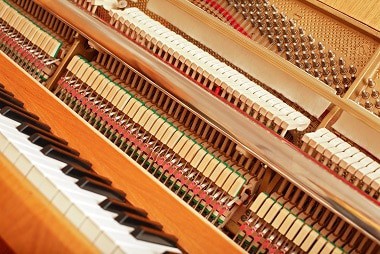
Overall the cast iron plate is designed to withstand a ridiculous amount of tension; several tens of thousands of pounds to be exact!
Looking at the inside of the piano you might notice that the strings are at varying lengths. The bass notes of the piano, for example, require longer strings in order to produce big enough vibrations. On the other hand, the treble strings have much shorter strings, and for some of those notes, there is no damper head.
Each note usually has three strings associated with it. That means if you were to do the math there are well over 250 individual strings per piano! When you press the key, the hammer will strike all three of those strings which produce a rich sound.
In some cases, the hammer can be adjusted with the pedal to reduce the number of strings that are struck too. When it comes to upright pianos the design is a little different but functions the same way. The strings sit vertically against the back of the piano, and then the hammers strike from a different angle.
What Is The Piano Soundboard
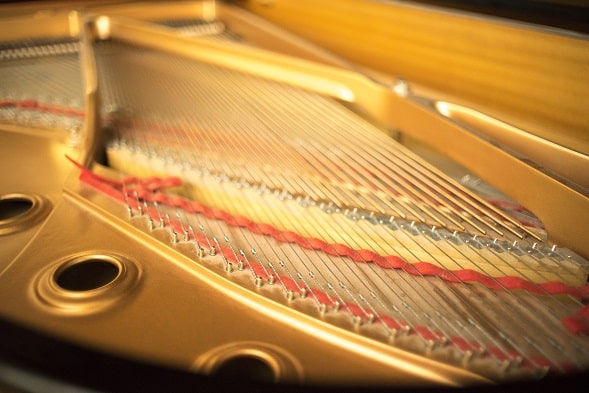
The smooth spruce wood base of the piano is called the soundboard. It’s constructed with a thin body and also has holes of various shapes made into it. Spruce is the wood of choice for its flexibility despite being so thin. It comes in a variety of sizes depending on the size of the piano.
Although the soundboard of a piano looks like one big flat piece, it’s actually a combination of different pieces that are fused together. Upon closer examination, you can see the soundboard is ribbed to help with projecting more volume. The upper part of the soundboard is called the belly, and it’s where the majority of the spruce is found. The back part of the soundboard is almost always a hardwood.
Every soundboard has a series of hardwood bridges installed across the top. This is where the strings connect to the soundboard. Since the strings are made with metal and have high tension, the hardwood is heavily layered to prevent grooves from forming.
Each soundboard has bridges of varying lengths; usually one long and one short bridge. On a grand piano, the short bridge is located in the back of the instrument and the long bridge is across the front section.
When it comes to shape and install, the soundboard takes on the body of the grand piano entirely. Upright pianos are usually a little different and it’s a separate vertical piece altogether.
The soundboard functions as an amplifier system for the piano. Whenever a note is played, the vibrations of the strings hovering over the soundboard is magnified. The soundboard will take those airwaves, and vibrate at whatever frequency the strings are vibrating at.
The biggest difference, of course, is the tone that the soundboard produces vs the strings themselves. Rather than a thin, and tinny sound, a much different timbre is achieved here and it’s at the same exact pitch the strings would produce on their own.
How To Use Piano Pedals
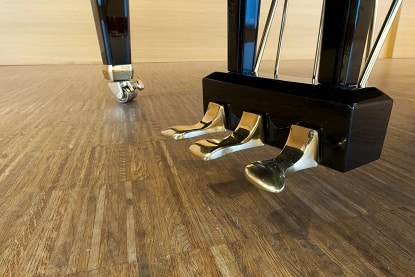
A major functioning component of pianos and making them work well are the pedals. Since the piano is not a wind instrument, the only way to make those adjustments is by using the pedals.
Many pianos are equipped with three pedals. Each of these pedals has a very distinct function that can completely change the sound of a piece. Below is a list of the 3 pedals most pianos have:
- Sustain Pedal
- Sostenuto Pedal
- Soft Pedal
How The Sustain Pedal Works
Often called the damper pedal, the sustain pedal is the one used most often by pianists. This pedal is responsible for allowing a pianist to play a key, and for that sound to resonate long after the key is released. This pedal is located on the furthest to the right of all the pedals.
It’s responsible for lifting all of the dampers up at once, so any key you press will sustain that pitch until the natural vibration is done. Pianists can play as many notes as they want to and it will continue to carry the tone as long as the pedal is pushed down.
The sustain pedal is particularly useful for making empty sounding passages to sound fuller and connected. The sustain pedal is used sparingly in most Baroque-era pieces; Bach and Scarlatti are good examples of that style. When it comes to Classical and Romantic era pieces, the pedal is much more prominent and written into the score.
The pedal can be depressed at various levels to create unique sounds. For a blurry effect, you can press down fully with your right foot. For a medium, to light blur, you can simply apply less pressure.
How The Sostenuto Pedal Works
Much like the sustain pedal, the sostenuto pedal also lifts up the dampers to sustain notes. In this case, the sostenuto pedal will only sustain notes that are pressed at keys that are pressed at the same time. That means any notes played after won’t have raised dampers.
Not many pieces make use of the sostenuto pedal, but it is widely used in the opening movement of Debussy’s Pour Le Piano Suite. The low A is sustained in the left hand with the sostenuto pedal while the right-hand plays without interfering harmonically.
On upright pianos, the sostenuto pedal has a different function. The pedal can be pushed down and then shifted over to lock into place. This moves of a small amount of felt material between the hammers and strings and to effectively mute the piano to a degree. The primary purpose of it is for quiet practicing.
How The Soft Pedal Works
Often referred to as the una corda, the soft pedal is often used for pianissimo passages in music. It’s unique because the pianist can still play with a great deal of force but achieve a much softer volume level without having to make any adjustments to the amount of touch they apply to the keys.
Not all soft-pedals are equal though, so it’s important to have your piano technician make adjustments to it and customize it to your liking.
Usually the hammers of the piano strike all three strings to produce a full tone. However, you’ll notice that whenever playing the soft pedal the keyboard itself will shift to the right. This is because the pedal shifts the entire action over so that one less string is struck by the hammers. Because one string is being struck, the notes tone quality is changed and it’s much softer.
Why The Piano Body Is Important
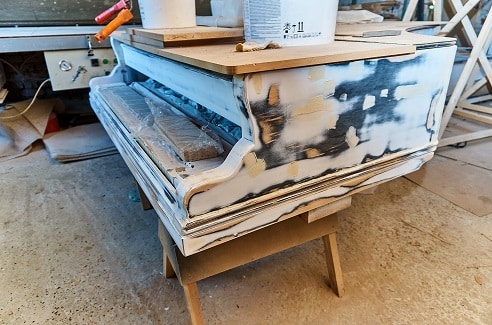
Whether it’s an upright piano or a beautiful concert grand, the body of the instrument has a very important place in the pianos overall makeup. From the shape, size, and finish, the piano body houses everything from the action to the soundboard and other important parts.
The body of a piano is made up of several thin sheets of wood that have been stacked and pressed together. In most piano factories this wood is then glued together and then bent on a patented frame. What we’re left with is a dove-shaped instrument in the case of a grand piano.
The part that affects the tone most is rim. Pianos with thicker rims tend to produce less of a bright tone, and you’ll often find that in high-end Steinway and Yamaha instruments.
On top of the piano is the lid which can be used to adjust the volume level naturally. The lid can be adjusted to varying levels from half stick to full stick. When a pianist plays a note, that sound is projected upward. The sound bounces off the lid and then travels out to the recital hall. Depending on where you are located in the room, you may get more sound by being on one side of the piano than the other.
The finish of the piano also has a great impact on its overall sound quality too. Most pianos have an ebony finish, and others have satin or wood.
How Digital Pianos Work
The way the modern piano works is really unique. With the advancement in technology though, there are many digital pianos that are able to achieve the same sort of feel and touch by similar means.
Most digital pianos feature something called hammer action. It’s a replication of the hammer action we discussed earlier in this article. In this case, when you press a key, there’s actually a small hammer inside that strikes a sensor to create sound.
In fact, Kawaii has built a mechanism in their hammer action series that looks a lot like the standard acoustic piano action. The part features a key pivot joint, triple sensor, counterweights, and more.
Rather than the sound always be at the same volume, this replication hammer action allows for you to produce realistic volume levels depending on how hard the hammer strikes the sensor.
Another way digital pianos achieve realistic effects is through the samples they use. In the past, most digital pianos only had computerized midi sound effects that were not pleasing to most players. These days they feature actual sounds from real grand pianos.
Audio engineers capture the sounds of Yamaha’s, Steinway, and other popular models. That sound is then mapped to each individual key. The engineers then adjust the keys so that real-time decay and release of the pitches is achieved.
Most of the samples used on today’s digital pianos are several thousands of gigabytes large in file size. These pianos have enough power to process those sounds without losing any audio quality and without lag and distortion.
Many digital pianos feature resonance options so that pianists can replicate rooms of different sizes and acoustics. Other cool features you might find on a digital piano are rapid repetition control with both the keys and the pedaling too. The sostenuto and soft pedal are also widely featured on the Yamaha Clavinova keyboard consoles.
Advanced Acoustic Piano Features
A very popular trend in the development of pianos today is the ability for them to play themselves. The most popular systems on the market right now are Disklavier by Yamaha and Spirio by Steinway.
These are considered to essentially be hybrid pianos. Pianists can record themselves, insert a disc, or even use their smartphones to communicate with the system that is installed on the piano.
When a song is chosen, the piano will play the song back note for note, dynamic for dynamic. Some pianos even administer pedaling during these performances too.
These hybrid pianos work by using sensors that are attached to the keys, hammers, and pedals. Some pianos like the Disklavier models use electromagnetic components to convert electrical energy into mechanical energy to achieve this.
It’s all achieved by using a solenoid. To help ensure that things always work properly, these systems have calibration settings so that the piano can reset itself. This is really helpful considering pianos have a ton of moving parts.
Hello & thanks for stopping by! I’m a professional concert pianist and piano instructor. In the United States, I’ve given successful performances in several places including New York, Florida, Connecticut, & New Jersey, I have also performed internationally in Italy and made my Carnegie Hall debut in 2014. I enjoy blogging about the piano, the art of performance, general music, current events and the latest in music production.

Upright Piano Vs Grand Piano - Joshua Ross
Thursday 21st of February 2019
[…] In comparison with upright pianos, the hammer relies on springs returning to their default resting position. Learn more about how a piano works here. […]
Top 15 Best Digital Piano For Beginners - Joshua Ross
Thursday 10th of January 2019
[…] When played, it’ll feel as if a real hammer is released to strike the strings via the damper; this is how a piano works. […]
Why Does Piano Have Black And White Keys - Joshua Ross
Thursday 10th of January 2019
[…] a pianist, most of us know the basics of how the piano works. We understand the pedaling, notation, and how the different patterns like the 2 black keys and the […]
Difference Between Hammer Action And Weighted Keys - Joshua Ross
Thursday 10th of January 2019
[…] Compared to an acoustic piano, the action is not nearly the same sort of resistance and weight across the board. Read here to see how acoustic pianos work. […]